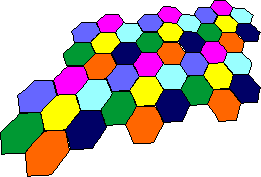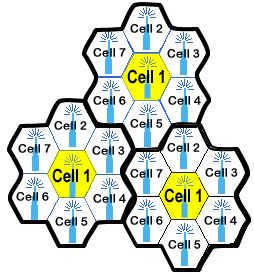Cellular Concept and Frequency Reuse
CELLULAR CONCEPT AND FREQUENCY REUSE
In the cellular concept, frequencies allocated to the service are re-used in a regular pattern of areas, called ‘cells’, each covered by one base station. In mobile-telephone nets these cells are usually hexagonal. In radio broadcasting, a similar concept has been developed based on rhombic cells.
To ensure that the mutual interference between users remains below a harmful level, adjacent cells use different frequencies. In fact, a set of C different frequencies {f1, . . .fC} are used for each cluster of Cadjacent cells. Cluster patterns and the corresponding frequencies are re-used in a regular pattern over the entire service area.

| Frequency reuse plan for C = 3, with hexagonal cells. (i=1, j =1) | Frequency reuse plan for C = 7 (i=2, j =1). |
The total bandwidth for the system is C times the bandwidth occupied by a single cell.
Frequency reuse:
Frequency reuse was implemented by restructuring the mobile telephone system architecture into the cellular concept.
The concept of frequency reuse is based on assigning to each cell a group of radio channels used within a small geographic area. Cells are assigned a group of channels that is completely different from neighbouring cells. The coverage area of cells is called the footprint. This footprint is limited by a boundary so that the same group of channels can be used in different cells that are far enough away from each other so that their frequencies do not interfere.

Cells with the same number have the same set of frequencies. Here, because the number of available frequencies is 7, the frequency reuse factor is 1/7. That is, each cell is using 1/7 of available cellular channels.
Cell splitting:
- To minimize interference, a certain distance must be maintained between cells using the same frequencies. However, this distance can be reduced without disturbing the cell reuse pattern. As the size of the cells are reduced, the same frequencies can be utilized in more cells, which in turn means more subscribers can be accommodated on the system.
- Particularly in congested areas, the cellular operator often splits an existing cell into two or more smaller cells. New transceivers are placed and the power of the transmitters are reduced in order to confine the signals to the newly created cells.
- For example, a cell that originally had a radius of 8 mi could be split into four cells with each new cell having a 2 mi radius. For the existing Analog system, cell splitting is an effective way to increase system capacity, although some practical limitations are reached. Suitable locations for cell sites becomes more difficult and the processing load on the switch rapidly increase because handoffs are more frequent.

Sectoring:
In cellular telephone system, co-channel interference can be decreased by replacing a single omnidirectional antenna with several directional antennas, each radiating within a smaller area.
Cell sectorization:
One way to increase to subscriber capacity of a cellular network is replace the omnidirectional antenna at each base station by three (or six) sector antennas of 120 (or 60) degrees opening.
Each sector can be considered as a new cell, with its own (set of) frequency channel(s).

The base station can either be located at
- The centre of the original (large) cell, or
- The corners of the original (large) cell.
The use of directional sector antennas substantially reduces the interference among co-channel cells. This allows denser frequency reuse.
Sectorization is less expensive than cell-splitting, as it does not require the acquisition of new base station sites.

